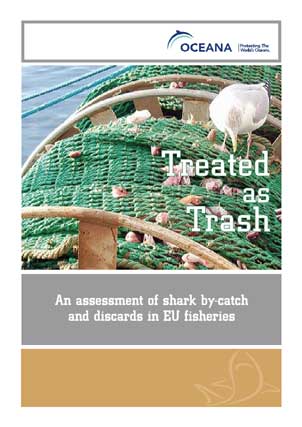Report | April, 2010
Treated as trash
Most of the pelagic (open water) sharks caught worldwide by European Union vessels come from the fisheries of modern Spanish and Portuguese surface longliner fleets which target them. In 2004, EU vessels reported 114,669 metric tons of shark and ray catches worldwide. More than 67 per cent of total shark catches in the Atlantic were taken in a surface longline fishery specialized in the capture of these animals. In the Indian and Pacific Oceans, all shark catches that are reported by EU fleets are taken in this kind of fishery. Another directed shark fishery is carried out by the gillnetting fleet, catching deep-sea sharks for their meat and livers. However, this picture alone is far from complete, as large quantities of elasmobranches (sharks and related species such as rays) are accidentally caught (known as by-catch) in all types of fisheries.
“By-catch” is defined as “the unintentional or incidental capture of non-target species during fishing operations”. Different types of fisheries take different species as by-catch at differing levels, depending on the type of fishing gear used, and the time, area and depth at which it is employed. By-catch of non-target species is common in most fisheries, but by-catch of sharks is particularly problematic. These animals usually have slower growth rates than the target fish species, and can therefore be seriously depleted through excessive by-catches, even when the target fish species are within sustainable levels.
The “finning” of accidentally-caught sharks (the removal of the valuable fins and subsequent disposal of the bodies back to sea), especially on French longliners in the Indian Ocean and Spanish and French purse seiners in the Atlantic, was formerly common practice. However, this practice is now prohibited for European Union vessels and in most waters worldwide.
Sharks are accidentally caught in many and very different gillnet, purse seine, longline and trawl fisheries, and from small artisanal boats to giant industrial vessels. This report focuses on a few examples to show the dimension of the problem.




